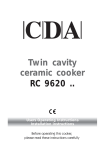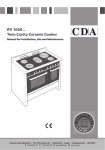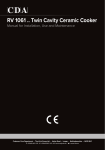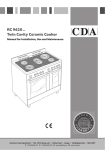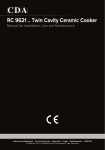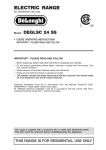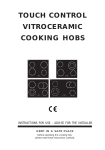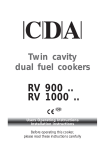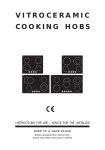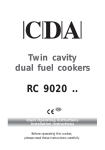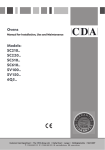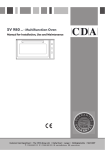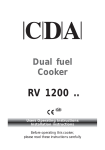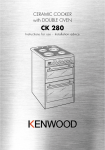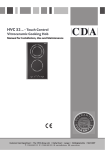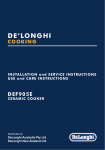Download CDA RV1060SS cooker
Transcript
Twin cavity ceramic cooker RV 1060 .. Users Operating Instructions Installation instructions Before operating this cooker, please read these instructions carefully Dear Customer Thank you for choosing one of our appliances, carefully designed and built by our specialist staff and thoroughly tested to satisfy your cooking requirements. We suggest that you read this Instruction Booklet so that you will understand fully how to operate your appliance. Please keep the booklet handy. You may wish to refer to it at a later date. CDA IMPORTANT INFORMATION FOR CORRECT DISPOSAL OF THE PRODUCT IN ACCORDANCE WITH EC DIRECTIVE 2002/96/EC. At the end of its working life, the product must not be disposed of as urban waste. It must be taken to a special local authority differentiated waste collection centre or to a dealer providing this service. Disposing of a household appliance separately avoids possible negative consequences for the environment and health deriving from inappropriate disposal and enables the constituent materials to be recovered to obtain significant savings in energy and resources. As a reminder of the need to dispose of household appliances separately, the product is marked with a crossed-out wheeled dustbin. Important: This appliance is designed and manufactured solely for the cooking of domestic (household) food and is not suitable for any non domestic application and therefore should not be used in a commercial environment. The appliance guarantee will be void if the appliance is used within a non domestic environment i.e. a semi commercial, commercial or communal environment. 2 Contents Models RV 1060 .. Page Number Introduction . . . . . . . . . . . . . . . . . . . . . . . . . . . . . . . . . . . . . . . . . . . . . . 4 Assembling the backguard . . . . . . . . . . . . . . . . . . . . . . . . . . . . . . . . . . . . 4 Features and technical data . . . . . . . . . . . . . . . . . . . . . . . . . . . . . . . . . . . 5 Control panel . . . . . . . . . . . . . . . . . . . . . . . . . . . . . . . . . . . . . . . . . . . . . 6 Clock and timer with “Touch-Control” keys (main oven only) . . . . . . . . . . . 7 How to use the vitroceramic hob . . . . . . . . . . . . . . . . . . . . . . . . . . . . . . 10 How to use the multifunction main oven . . . . . . . . . . . . . . . . . . . . . . . . 15 How to use the conventional oven . . . . . . . . . . . . . . . . . . . . . . . . . . . . 21 Do’s and do not’s . . . . . . . . . . . . . . . . . . . . . . . . . . . . . . . . . . . . . . . . . . 25 Important notes . . . . . . . . . . . . . . . . . . . . . . . . . . . . . . . . . . . . . . . . . . . 26 Care and maintenance . . . . . . . . . . . . . . . . . . . . . . . . . . . . . . . . . . . . . 27 For the installer Location . . . . . . . . . . . . . . . . . . . . . . . . . . . . . . . . . . . . . . . . . . . . . . . . 33 Levelling the cooker - Moving the cooker . . . . . . . . . . . . . . . . . . . . . 34-35 Stability bracket . . . . . . . . . . . . . . . . . . . . . . . . . . . . . . . . . . . . . . . . . . . 36 Electrical installation . . . . . . . . . . . . . . . . . . . . . . . . . . . . . . . . . . . . . . . . 37 Appliance servicing . . . . . . . . . . . . . . . . . . . . . . . . . . . . . . . . . . . . . . . . 39 Guarantee . . . . . . . . . . . . . . . . . . . . . . . . . . . . . . . . . . . . . . . . . . . . . . . 40 3 Introduction Congratulations on your purchase of this CDA cooker which has been carefully designed and produced to give you many years of satisfactory use. Before using this appliance it is essential that the following instructions are carefully read and fully understood. We would emphasise that the installation section must be fully complied with for your safety to ensure that you obtain the maximum benefits from your appliance. Fig. 1 B Assembling the backguard Before installing the cooker, assemble the backguard “V” (fig. 1). Please note that : A V Declaration of CE ■ The backguard “V” can be found packed at the rear of the cooker. ■ Before assembling remove any protective film/adhesive tape. ■ The backguard must be fixed to the cooktop using the three supports “B” supplied with the appliance (see fig. 1). conformity ✓ This cooker has been designed, constructed and marketed in compliance with: - Safety requirements of EU Directive "Low Voltage" 2006/95/EC; - Protection requirements of EU Directive "EMC" 89/336/EEC; - Requirements of EU Directive 93/68/EEC. 4 Features and technical data Vitroceramic cooking hob 1. 3 circuits cooking zone Ø 180 2. 3 circuits cooking zone Ø 145 3. Oval cooking zone Ø 145 x 250 4. Double cooking zone Ø 210/120 5. 3 circuits cooking zone Ø 145 6. Cooking zone residual heat indicators 1700 W 1200 W 1800/1000 W 2100/700 W 1200 W 3 Attention: Detach the appliance from the mains if the ceramic hob is cracked and contact the After-Sales service. 4 5 1 2 6 Conventional oven Fig. 2 Multifunction oven 5 Control panel Fig. 3 8 13 11 7 6 5 4 12 3 2 1 10 9 Control panel - Controls description 1. Front right cooking zone control knob 2. Rear right cooking zone control knob 3. Central cooking zone control knob 4. Rear left cooking zone control knob 5. Front left cooking zone control knob 6. Multifunction main oven switch control knob 7. Multifunction main oven thermostat control knob 8. Clock and timer with “Touch-Control” keys (main oven only) 9. Conventional oven thermostat control knob 10.Conventional oven switch control knob Pilot lamps: 11. Main oven thermostat indicator light 12. Conventional oven thermostat indicator light 13. Cooking hob ON indicator light Please note: This appliance incorporates a safety cooling fan which you will hear operating whenever the oven or grill are in use. This fan is to reduce the external temperature of the appliance and cool the internal components. 6 Clock and timer with “Touch-Control” keys (main oven only) keys + and – MODE Touched simultaneously (for more than 2 seconds): • setting the clock; • setting the timer volume (by touching once, along with the “MODE” key); • to cancel automatic cooking at any time. Function selection (touched for more than 2 seconds): • setting the clock (only after first connection or after a power failure); • timer; Fig. 4 • automatic cooking “dur” (duration) - how long the food will take to cook (by touching the “MODE” key again); • automatic cooking “End” - the time you would like the oven turns off (by touching the “MODE” key two more times); + Increases the number shown on the display – Decreases the number shown on the display Illuminated symbols: AUTO flashing - automatic cooking completed, oven in automatic position but not set AUTO steady illumination - oven set for automatic cooking, cooking still not taking place “ ” flashing - timer being set “ ” steady illumination - timer in operation “ ” steady illumination - oven set for manual cooking “ ” and AUTO AUTO flashing - automatic cooking being set “ ” and AUTO steady illumination - oven set for automatic cooking, cooking taking place. 7 “TOUCH-CONTROL” keys The “touch-control” keys shall be operated by the fingers (just by touching the key). When using touch controls it is best to use the ball of your finger rather than the tip. The keys are automatically deactivated: • 8 seconds after the last selection; the deactivation is indicated by an acoustic signal (“beep”). To reactivate just touch the “MODE” key or the “+” and “–” keys (simultaneously) for more than 2 seconds. Setting the clock When first connected, or after a power failure, the digits and “AUTO” will shown on the display. To set the clock, touch the “MODE“ key, for more than 2 seconds, and then the “+” or “–” keys. Important: the oven does not operate, in manual cooking, without first having set the clock. To set the clock, with the appliance already connected, touch the “+” and “–” keys simultaneously (for more than 2 seconds), then “+” or “–” keys. Important: • changing the time will delete any automatic program; • after setting the clock, the oven starts to operate in the selected function (manual cooking). The “ ” symbol is steady illuminated. Using the timer You can use the timer at any time, even when the oven is not in use. The timer does not turn the oven off. The timer can be set for up to 23 hours and 59 minutes. • To set the timer, touch the “MODE” key for more than 2 seconds (the “ ” symbol flashes), than the “+” or “–” keys. • After about 8 seconds an acoustic signal (“beep”) will sound confirming the regulation (“ ” symbol steady illuminated). • To check the remaining time touch the “MODE“ key for more than 2 seconds. If the remaining time is more than a minute the display will show hours and minutes; if less than a minute the display will show seconds. • When the time is up, the timer will beep. Touch the “MODE” key , for more then 2 seconds, to turn it off; or press the “+” or “–” key to stop the beep and than the “MODE” key, for more than 2 seconds, to deactivate the “ ” symbol flashing on the display. • Turn off the oven manually (function and thermostat knobs in the off position) if the manual cooking has been completed. 8 Setting the timer volume You can select from three volume levels. • Touch the “+” and “–” keys simultaneously for more than 2 seconds. • Touch the “MODE” key; you can read on the display the current timer volume (“ton1”, “ton2” or “ton3”). • Touch the “–” key to listen or change the timer volume. • Timer volume activated: the last displayed. • After about 8 seconds an acoustic signal (“beep”) will sound confirming the volume setting; then the time of day will be displayed. Automatic cooking Use automatic cooking to automatically turn the oven on, cook, and then turn the oven off. 1. Check the clock shows the correct time. 2. Select the function and temperature (function and temperature knobs). The oven will come on. 3. Decide how long the food will take to cook, allowing time for preheating if necessary. 4. Touch the “MODE” key for more than 2 seconds and then touch again. “dur” will show (duration). Using the “+” and “–” keys, set the cooking time. 5. Decide the time you would like the oven to turn off; touch the “MODE” key for more than 2 seconds and then touch it two times again. “End” will show. Using the “+” and “–” keys, set the cooking time. Note: while “dur” is displayed you can change to “End” just by touching one time the “MODE” key (within 8 seconds from the last selection). If there is time to wait before cooking starts, the current time of day and “AUTO” will show in the clock display. The oven will switch off but is now set for automatic cooking. If you are already at home to turn the oven on and only want the oven to turn off automatically, start cooking as normal, then follow step 4 or step 5 to set a time to stop the oven. When automatic cooking starts, “ ” will be displayed and the oven will turn on. • To see the remaining cook time, follow step 4 up to display “dur” (duration). • To see the set stop time, follow step 5 up to display “End”. • To cancel automatic cooking at any time, touch the “+” and “–” keys simultaneously (for more than 2 seconds) and turn the temperature and function knobs to the off position. When the stop time is reached, the oven will turn off, the timer will beep and “AUTO” will flash: • Touch any key to stop the beeping. • Touch the “MODE” key, for more than 2 seconds, to return the oven to the manual mode (“ ” symbol steady illuminated on the display). • Turn the temperature and function knobs to the off position. Attention: after a power failure any automatic program is deleted. Turn off the oven manually. 9 How to use the vitroceramic hob The ceramic surface of the hob allows a fast transmission of heat in the vertical direction, from the heating elements underneath the ceramic glass to the pans sat on it. The heat does not spread in the horizontal direction, so that the glass stays “cool” at only a few centimeters from the cooking plate. The 5 cooking plates are shown by painted disks on the ceramic surface. Important note: The heating elements incorporate a thermolimiter that switches the element ON/OFF during all the settings to protect the ceramic glass from overheating. The use of incorrect pans and/or wrong pan positioning will cause the temperature limiter to operate more frequently, resulting in a reduction of cooking performance. 3 circuit radiant zones Incorporating 3 heating elements (fig. 6) you can control and light up all 3 together or separately by selecting from the 6 positions on the control knob (fig. 5). The working temperature required is reached in a very short time. Fig. 5 10 Fig. 6 Double and oval radiant zones The heating element is formed of a coil of resistant material which reaches the working temperature quickly. Operation of the cooking zone is controlled by a continuous energy regulator from “1” to “12” (maximum temperature) (fig. 7). By switching on the second element (fig. 8 and 9), the surface area of the rear right and central radiant zones can be extended. For this purpose, turn the control knob (fig. 7) fully to the right (position ). Fig. 7 Second element Fig. 8 Second element Fig. 9 11 Cooking hints Cooking plate controlled by a 7 position switch Cooking plate controlled by a 12 position switch 1 1 2 Knob setting 0 0 Switched OFF 1 2 For melting operations (butter, chocolate). 4 1 2 2 2 3 4 To maintain food hot and to heat small quantities of liquid (sauces, eggs). 4 5 6 To heat bigger quantities; to whip creams and sauces. (vegetables, fruits, soups). 3 6 4 7 Slow boiling, i.e.: boiled meats, spaghetti, soups, continuations of steam cooking of roasts, stews, potatoes. 4 7 8 For every kind of frying, cutlets, uncovered cooking, i.e.: risotto. 8 4 9 5 10 Browning of meats, roasted potatoes, fried fish, omelettes, and for boiling large quantities of water. 6 11 12 Fast frying, grilled steaks, etc. 3 2 3 5 3 6 7 8 4 9 10 5 11 12 6 Type of cooking Switching on the second element (Double and oval radiant plate only) Heating Cooking After a short period of use, experience will teach you which setting is the right one for your needs. Roasting-frying Fig. 10 12 Residual heat indicator The hob also features 5 warning lights which are connected to the corresponding plates. When the temperature of a cooking plate is above 60°C, the relevant warning light will also light up to warn of heat on the surface of the hob. This light also stay on after the cooking plate has been switched off to show that the hob surface is still hot. This residual heat will lasts for a long time after the cooking plate has been switched off. During this time you should avoid touching the hob surface over the cooking area. Please pay special attention to ensure that children are not allowed near the hob. The light will switch off automatically as soon as the surface temperature of the cooking plate falls below 60°C. Caution! the cooking hob becomes very hot during operation. Keep children well out of reach. Cooking hints: – To reduce the cooking time, you can turn the control knob to the max when you switch the plate on. After a short time you can set the control knob to the position required for cooking. – You should only use pots and pans with flat bases (pans with the test mark for glass-ceramic hobs are available from specialist shops). The diameter of the pan should match that of the cooking plate (or be slightly bigger) to make the most of the energy. – Since the cooking surface will stays hot for a certain time after the plate has been switched off, you can switch it off 5 or 10 minutes before the end of the cooking. The residual heat of the hob will complete the cooking. – To save electricity, use pan lids whenever possible. – Never cook the food directly on the glass ceramic cooktop. Deep fat frying Fig. 11 DO NOT USE GLASSWARE ON CERAMIC HOBS. DO NOT USE PANS WITH ROUGH CIRCULAR MACHINED BASE. For safety purposes when deep fat frying, do not fill the pan more than one third full of oil. DO NOT cover the pan with a lid and DO NOT leave the pan unattended. In the unfortunate event of a fire, leave the pan where it is and turn off the control knobs. Place a damp cloth or lid over the pan to smother the flames. Leave the pan to cool for at least 30minutes before moving the pan. DO NOT USE WATER ON THE FIRE. 13 Safety hints: Cleaning the hob – Before you switch the hob on, make sure you know which knob controls the required cooking plate. We advise you to set the pan over the cooking plate before switching it on. Remove the pan after you have switched the cooking plate off. – Do not use pots and pans with rough bases (pay attention to cookware made of cast-iron). Rough bases can damage (scratch) the glass surface of the hob. Make sure that the bottom of the pan is dry and clean. – Pots with aluminium bottoms may leave silver streaks or spots on the hob. – Do not leave wet or damp lids on the hob. – The glass-ceramic surface and pans must be clean. Carefully remove any food debris (especially containing sugar), dirt etc. with the aid of a cleansing agent. – Pan handles should never stand out beyond the kitchen worktop, as there is a great danger of knocking the pan over. This will also ensure that children cannot reach them. – Do not use the hob if the glass surface is broken or cracked in any way. Please disconnect the hob from the mains and contact the after-sales service. – Do not lean over the cooking plate when in use. – Do not lay cooking foil or plastic materials on the ceramic surface when it is hot. – Remember that the surface remains hot for a long time (about 30 min.) after the cooking plate has been switched off. – Follow the cleaning instructions carefully. Before you begin cleaning make sure that the appliance is switched off. Do not use the glass surface for storage. 14 Remove spillages and other types of incrustations. Dust or food particles can be removed with a damp cloth. If you use a detergent, please make sure that it is not abrasive or scouring. Abrasive or scouring powders can damage the glass surface of the hob. All traces of the cleaner must be removed with a damp cloth. Do not put articles on the hob which can melt: i.e plastic, aluminium foil, sugar, sugar syrup mixtures etc. If any of these products items have melted on the ceramic surface, you should remove it immediately (when the surface is still hot) by using a scraper to avoid any permanent damage to the surface of the hob. (Available under part No. 103138). Avoid using a knife or other sharp utensils since these can damage the ceramic. Do not use steel wool or an abrasive sponge which could scratch the surface permanently. ATTENTION: MOST IMPORTANT! If cleaning the glass ceramic hob using a special scraper tool take extra care to avoid damaging the seal at the edges of the glass ceramic surface. Fig. 12 How to use the Multifunction main oven General features As its name indicates, this is an oven that presents particular features from an operational point of view. In fact, it is possible to insert 7 different programs to satisfy every cooking need. The 7 positions, thermostatically controlled, are obtained by 4 heating elements which are: – Bottom element 1200 W – Top element 1000 W – Grill element 2000 W – Circular element 2200 W Note: Upon first use, it is advisable to operate the oven for 30 minutes in the position and for another 30 minutes at the maximum temperature (thermostat knob on position 250) in the and , to eliminate possible traces of grease on the heating elements. positions Clean the oven and accessories with warm water and washing-up liquid. WARNING: The door is hot, use the handle. ATTENTION - MOST IMPORTANT Pay special attention not to touch the hot heating element inside the oven cavity. Operating principles Heating and cooking in the MULTI-FUNCTION oven are obtained in the following ways: a. by normal convection The heat is produced by the upper and lower heating elements. b. by forced convection A fan sucks in the air contained in the oven muffle, which sends it through the circular heating element and then sends it back through the muffle. Before the hot air is sucked back again by the fan to repeat the described cycle, it envelops the food in the oven, provoking a complete and rapid cooking. It is possible to cook several dishes simultaneously. c. by semi-forced convection The heat produced by the upper and lower heating elements is distributed throughout the oven by the fan. d. by radiation The heat is radiated by the infra red grill element. e. by radiation and ventilation The irradiated heat from the infra red grill element is distributed throughout the oven by the fan. f. by ventilation The food is defrosted by using the fan only function without heat. 15 Fig. 13 Fig. 14 Thermostat knob (Fig. 13) This only sets the cooking temperature and does not switch the oven on. Rotate clockwise until the required temperature is reached (from 50 to 250°C). The light between the thermostat and the function selector will illuminate when the oven is switched on and turns off when the oven reaches the correct temperature. The light will cycle on and off during cooking in line with the oven temperature. Function selector knob (Fig. 14) Rotate the knob clockwise to set the oven for one of the following functions. Oven light By setting the knob to this position, only the oven light comes on. It remains on in all the cooking modes. Traditional convection cooking The upper and lower heating elements come on. The heat is dispersed by natural convection and the temperature must be set to between 50° and 250°C via the thermostat knob. The oven must be preheated before cooking. Recommended for: Food that requires the same degree of cooking both inside and out, for example roasts, spare pork ribs, meringues etc. 16 Grilling The infrared grill element comes on. The heat is dispersed by radiation. Use with the oven door closed and the thermostat knob to position 225°C for max 15 minutes, then to position 175°C. For cooking hints, see the chapter “USE OF THE GRILL”. Recommended for: Intense grilling, browning, cooking au gratin and toasting etc. It is recommended that you do not grill for longer than 30 minutes at any one time. Caution: the oven door becomes very hot during operation. Keep children well out of reach. Defrosting frozen foods Only the oven fan comes on. Use with the thermostat knob set to “ ” - other positions have no effect. The food is thawed by ventilation without heating. Recommended for: Quick thawing of frozen foods; one kg requires approximately 1 hour. Thawing times vary according to the quantity and type of food to be thawed. Hot air cooking The circular element and fan come on. The heat is dispersed by forced convection and the temperature can be regulated to between 50° and 250°C via the thermostat knob. The oven does not require preheating. Recommended for: Food which has to be well-cooked outside and soft or rosy inside, for example lasagne, lamb, roast beef, whole fish etc. 17 Ventilated grill cooking The infrared grill element and the fan come on. The heat is dispersed mainly by radiation and the fan then distributes it all over the oven. Use with the door closed. The temperature can be regulated via the thermostat knob to between 50° and 175° max. The oven must be preheated for approximately 5 minutes. For cooking hints, see the chapter “GRILLING AND AU GRATIN. Recommended for: Grilling where quick browning on the outside is required to keep the juices in. For example: veal steaks, chops, hamburgers etc. It is recommended that you do not grill for longer than 30 minutes at any one time. Caution: the oven door becomes very hot during operation. Keep children well out of reach. Maintaining temperature after cooking or slowly heating foods The upper heating element, the circular element and the fan come on. The heat is dispersed by forced convection with greater intensity in the upper part. The temperature can be set to between 50° and 150°C via the thermostat knob. Recommended for: Keeping food warm after any type of cooking. Slow heating of cooked food. Convection cooking with ventilation The upper and lower heating elements come on and the fan. The heat coming from above and below is dispersed by convection with ventilation. The temperature can be set to between 50° and 250°C via the thermostat knob. Recommended for: Voluminous dishes and large quantities which require the same degree of cooking both inside and out, for example rolled roasts, turkey, roast legs, cakes etc. 18 Cooking advice Sterilization Sterilization of foods to be conserved, in full and hermetically sealed jars, is done in the following way: a. b. c. d. Set the switch to position . Set the thermostat knob to position 185 °C and preheat the oven. Fill the dripping pan with hot water. Set the jars onto the dripping pan making sure they do not touch each other and the door and set the thermostat knob to position 135 °C. When sterilization has begun, that is, when the contents of the jars start to bubble, turn off the oven and let cool. Regeneration Set the switch to position and the thermostat knob to position 150° C. Bread becomes fragrant again if wet with a few drops of water and put into the oven for about 10 minutes at the highest temperature. Simultaneous cooking of different foods The MULTI-FUNCTION oven set on position and gives a simultaneous heterogeneous cooking of different foods. Different foods such as fish, cake and meat can be cooked together without mixing the smells and flavors together. This is possible since the fats and vapors are oxidized while passing through the electrical element and therefore are not deposited onto the foods. The only precaution to follow are: – The cooking temperatures of the different foods must be as close to as possible, with a maximum difference of 20° - 25 °C. – The introduction of the different dishes in the oven must be done at different times in relation to the cooking times of each one. The time and energy saved with this type of cooking is obvious. 19 Grilling and “au gratin” Grilling may be done without the roasting jack on position of the switch, because the hot air completely envelops the food that is to be cooked. Set the thermostat to position 175 °C and after having preheated the oven, simply place the food on the rack. Close the door and let the oven operate with the thermostat on position 175 °C, until grilling is done. Adding a few dabs of butter before the end of the cooking time gives the golden “au gratin” effect. It is recommended that you do not grill for longer than 30 minutes at any one time. Caution: the oven door becomes very hot during operation. Keep children well out of reach. Roasting To obtain classical roasting, it is necessary to remember: – that it is advisable to maintain a temperature between 180° and 200 °C. – that the cooking time depends on the quantity and the type of foods. Use of the grill Preheat the oven for about 5 minutes. Introduce the food to be cooked, positioning the rack as close to the grill as possible. The dripping pan should be placed under the rack to catch the cooking juices and fats. Grilling with the oven door closed. Do not grill for longer than 30 minutes at any one time. Caution: the oven door becomes very hot during operation. Keep children well out of reach. 20 How to use the Conventional oven General features As its name indicates, this is an oven that presents particular features from an operational point of view. The conventional oven is provided with 3 heating elements which are: – Bottom element – Top element – Grill element 800 W 700 W 1450 W Note: Upon first use, it is advisable to operate the oven at the maximum temperature (thermostat knob on position 250) for 60 minutes in the position and for another 15 minutes in the position to eliminate possible traces of grease on the heating elements. WARNING: The door is hot, use the handle. ATTENTION - MOST IMPORTANT Pay special attention not to touch the hot heating element inside the oven cavity. Thermostat knob (Fig. 16) This only sets the cooking temperature and does not switch the oven on. Rotate clockwise until the required temperature is reached (from 50 to 250°C). The light between the thermostat and the function selector will illuminate when the oven is switched on and turns off when the oven reaches the correct temperature. The light will cycle on and off during cooking in line with the oven temperature. Fig. 15 Fig. 16 21 Function selector knob (Fig. 15) Rotate the knob clockwise to set the oven for one of the following functions. Oven light By setting the knob to this position, only the oven light comes on. It remains on in all the cooking modes. Traditional convection cooking The upper and lower heating elements come on. The heat is dispersed by natural convection and the temperature must be set to between 50° and 250°C via the thermostat knob. The oven must be preheated before cooking. In the position the rotisserie motor come on for cooking with the rotisserie. Recommended for: Food that requires the same degree of cooking both inside and out, for example roasts, spare pork ribs, meringues etc. Traditional grilling The infrared electrical resistance comes on. The heat is diffused by radiation. Use with the oven door closed and the thermostat knob to position 225°C for 15 minutes then to 175°C. In the position the rotisserie motor come on for cooking with the rotisserie. For cooking hints, see the chapter “USE OF THE GRILL”. Recommended for: Intense grilling, browning, cooking au gratin and toasting etc. It is recommended that you do not grill for longer than 30 minutes at any one time. Attention: the oven door becomes very hot during operation. Keep children away. 22 Use of the grill Switch the grill on, setting the two knobs: – Function selector to or position. – Thermostat selector to position 225°C for 15 minutes then to 175°C. Leave to warm up for approximately 5 minutes with the door closed. Place the food inside positioning the rack as near as possible to the grill. Insert the drip pan under the rack to collect the cooking juices. Grilling with the oven door closed and do not for longer than 30 minutes at any one time. Attention: the oven door becomes very hot during operation. Keep children away. Rotisserie The oven is equipped with a rotisserie. This device is made up of: – an electrical motor mounted on the rear part of the oven – a stainless steel rod, equipped with a detachable athermic grip and 2 recordable forks – a rod support to be inserted into the central rack holders of the oven. Use of the rotisserie – Insert the dripping pan into the lowest rack holders of the oven and insert the rod support into the intermediate rack holders. – Put the meat to be cooked onto the rod, being careful to secure it in the center with the special forks. – Insert the rod into the motor opening and rest it onto the support of the spit collar; then remove the grip by turning it to the left. The rotation direction of the rotisserie can be either clockwise or counter-clockwise. Fig. 17 23 Use of special dish rack This special shelf can be used as dish rack or turning over, as normal shelf for oven cooking. It must be inserted between the guides of the lateral racks. Using the special shelf as a dish rack Slide in the shelf on the guides, on the lower level of the lateral racks. The prongs where the plates are to be inserted, must be turned upwards. The shelf must be fitted so that the safety catch, which stops it sliding out, faces the bottom of the oven (see detail of figure 18). The plates must be positioned as indicated in figure 18. To facilitate this operation, pull the special rack up to the safety lock. KEEP ATTENTION: Plates are hot after warming. It is advisable to handle the plates using oven gloves. Using the special rack for normal cooking Slide in the shelf on the guides: the safety catch must be turned toward the oven base (see detail of figure 19). The flat surface can be used to put cooking pans or food directly on the rack - the dripping pan should be placed under the rack to catch the cooking juices and fats. Fig. 18 24 Fig. 19 Do’s and do not’s Do’s and do not’s • Do always grill with the oven door closed. • Do read the user instructions carefully before using the cooker for first time. • Do allow the oven to heat for one and a half hours, before using for the first time, in order to expel any smell from the new oven insulation, without the introduction of food. • Do clean your oven regularly. • Do remove spills as soon as they occur. • Do always use oven gloves when removing food shelves and trays from the oven. • Do not allow children near the cooker when in use. • Do not allow fat or oils to build up in the oven trays, or oven base. • Do not place cooking utensils or plates directly onto the oven base. • Do not grill food containing fat without using the grid. • Do not cover the grilling grid with aluminium-foil. • Do not use the oven tray for roasting. • Do not place hot enamel parts in water. Leave them to cool first. • Do not allow vinegar, coffee, milk, saltwater, lemon or tomato juice to remain in contact with enamel parts (inside the oven and on the oven tray). • Do not use abrasive cleaners or powders that will scratch the surface of the stainless steel and the enamel. • Do not attempt to repair the internal workings of your cooker. • Do remove the protective film before the first use. • Fire risk! Do not store flammable material in the ovens and in the bottom drawer 25 For your safety The product should only be used for its intended purpose which is for the cooking of domestic foodstuffs. Under no circumstances should any external covers be removed for servicing or maintenance except by suitably qualified personnel. Attention The appliance gets very hot, mainly around the cooking areas. It is very important that children are not left alone in the kitchen when you are cooking. Important notes Installation, and any demonstration, information or adjustments are not included in the warranty. The cooker must be installed by a qualified person in accordance with the relevant Standards. 26 Care and maintenance Important: As a safety measure, before you start cleaning the cooker be sure to disconnect it from the mains supply. Do not use a steam cleaner because the moisture can get into the appliance thus make it unsafe. The use of suitable protective clothing/gloves is recommended when handling or cleaning of this appliance. WARNING When correctly installed, your product meets all safety requirements laid down for this type of product category. However special care should be taken around the rear or the underneath of the appliance as these areas are not designed or intended to be touched and may contain sharp or rough edges, that may cause injury. Spillage Any spillage should be dealt with as soon as possible to prevent it becoming burnt on. Vitroceramic cooking hob - See page 14. Enamelled parts All the enamelled parts must be cleaned with a sponge and soapy water only or other non-abrasive products. Dry preferably with a microfibre or soft cloth. Stainless steel, aluminium, painted parts and silkscreen printed surfaces Clean using an appropriate product. Always dry thoroughly. Stainless steel surfaces: can be cleaned with an appropriate stainless steel cleaner. IMPORTANT: these parts must be cleaned very carefully to avoid scratching and abrasion. You are advised to use a soft cloth and neutral soap. CAUTION: Do not use abrasive substances or non-neutral detergents as these will irreparably damage the surface. 27 Oven doors - removing the inner pane of glass The inner pane of glass can easily be removed for cleaning. Removing the inner pane – Open the door to the full extent. – Gently pull out the inner pane of glass (Fig. 20a). – Clean the glass with an appropriate cleaner. – Dry thoroughly, and place the pane on a soft surface. – Now you can also clean the inside of the outer glass. Do not use harsh abrasive cleaners or sharp metal scrapers to clean the panes of glass since they can scratch the surface, which may result in shattering of the glass. Reassembling the inner pane – Check the correct positioning of the no.4 (four) silicon rubbers D (fig. 20b). – Check that you are holding the pane the correct way. You should be able to read the wording on it as it faces you. – Insert the inner pane in the left E and right F side guides (fig. 20c) and gently let it slide up to the retainers H (fig. 20d). It is normal the opened gap between the top edge of the inner glass and the top of the door. This allows the cooling air circulation. 28 Fig. 20a D Fig. 20b E F Fig. 20c H Fig. 20d Drawer – The drawer (fig. 21) comes out like a normal drawer. Attention: Do not store flammable material in the ovens, or the drawer. Fig. 21 29 Inside of oven The oven should always be cleaned after use when it has cooled down. The cavity should be cleaned using a mild detergent solution and warm water. Suitable proprietary chemical cleaners may be used after first consulting with the manufacturers recommendations and testing a small sample of the oven cavity. Abrasive cleaning agents or scouring pads/cloths should not be used on the cavity surface. NOTE: The manufacturers of this appliance will accept no responsibility for damage caused by chemical or abrasive cleaning. Fig. 22 Let the oven cool down and pay special attention no to touch the hot heating elements inside the oven cavity. Assembling and dismantling of the side runner frames – Fit the side runner frames into the holes on the side walls inside the oven (Fig. 22). – Slide the tray and rack into the runners (Fig. 23). The rack must be fitted so that the safety catch, which stops it sliding out, faces the inside of the oven. – To dismantle, operate in reverse order. Fig. 23 Changing the oven light 1. Disconnect the electrical power supply (for example, by switching off the main power switch). 2. Unscrew the light cover 3. Fit a new bulb. 4. Refit the cover. Note: Use only bulbs designed to resist up to 300°C with the following characteristics: 230 V, type E14 and same power (check watt power as stamped in the bulb itself) of the replaced bulb. 30 Removing the oven door Fig. 24a Please operate as follows: ● ● ● ● Open the door completely. The swivel retainers of the rh and lh hinges (fig. 24a) are hooked onto the metal bar above them (fig. 24b). Lift the oven door slightly. The noch on the bottom of the hinge will disengage (fig. 24c). Now pull the oven door forwards off the appliance. Release both hinge sections from the slots (fig. 24d). Fig. 24b Door assembly ● Grip the door (as indicated in figure 24) and refit it in reverse order of removing procedure. Fig. 24c Fig. 24d Fig. 24 31 FOR THE INSTALLER The appliance is designed and approved for domestic use only and should not be installed in a commercial, semi commercial or communal environment. Your product will not be guaranteed if installed in any of the above environments and could affect any third party or public liability insurances you may have. 32 Location Important – The appliance should be installed by a qualified electrician in compliance with the laws in force in your country and in observation of the instructions supplied by the manufacturer. Failure to comply with this condition will render the guarantee invalid. – Always disconnect the cooker from mains power supply before carrying out any maintenance operations or repairs. The cooker must be installed no less than 50 mm away from any side wall which exceed the height of the cooktop; The appliance must be housed in heat resistant units. The walls of the units must be capable of resisting temperatures of 75 °C above room temperature. Do not install the appliance near inflammable materials (eg. curtains). 450 mm 750 mm If the cooker is located on a pedestal it is necessary to provide safety measures to prevent falling out. 50 mm 500 mm A U T O Fig. 25 33 Levelling the cooker The cooker is equipped with 4 LEVELLING FEET and may be levelled by screwing or unscrewing the feet with a spanner (fig. 26). It is important to observe the prescriptions of figures 27a - 27b. Fig. 26 Fig. 27a 0 +8 mm Fig. 27b + 8 mm + 35 mm 34 Moving the cooker Warning When raising cooker to upright position always ensure two people carry out this manoeuvre to prevent damage to the adjustable feet (fig. 28). Warning Be carefull: do not lift the cooker by the door handle when raising to the upright position (fig. 29). Fig. 28 Warning When moving cooker to its final position DO NOT DRAG (fig. 30). Lift feet clear of floor (fig. 28). Fig. 29 Fig. 30 35 Stability bracket We recommend a stability bracket is fitted to the cooker. The type shown in fig. 31 can be purchased from most plumbers merchants and do it yourself (D.I.Y.) shops. Existing slot in rear of cooker Brackets Fig. 31 Dotted line showing the position of cooker when fixed 3 Outline of cooker backplate at the engagement slot Wall fixing Floor fixing Dimension is in millimetres 36 Electrical installation IMPORTANT: The cooker must be installed in accordance with the manufacturer’s instructions. Incorrect installation, for which the manufacturer accepts no responsibility, may cause injury to persons, animals or equipment. For your safety please read the following information: – Connection to the mains must be carried out by qualified technician in accordance with current regulations. – The appliance must be connected to the mains checking that the voltage corresponds to the value given in the rating plate and that the electrical cable sections can withstand the load specified on the plate. – The cooker can be connected directly to the mains placing an omnipolar switch with minimum opening between the contacts of 3 mm between the appliance and the mains. – The power supply cable must not touch any hot parts and must be positioned so that it does not exceed 75°C at any point. – Once the cooker has been installed, the switch must always be accessible. N.B. For connection to the mains, do not use adapters, reducers or branching devices as they can cause overheating and burning. If the installation requires alterations to the domestic electrical system, call an expert. He should also check that the domestic electrical system is suitable for the power absorbed by the appliance. – The connection of the appliance to earth is mandatory. The manufacturer declines all responsability for any inconvenience resulting from the none observance of this condition. IMPORTANT: this cooker must be connected to a suitable double pole control unit adjacent to the cooker. No diversity can be applied to this control unit. Before carrying out any work on the electrical parts of the appliance, the appliance must first be disconnected from the electrical supply. 37 Connecting the power cord must be entrusted to skilled personnel in accordance with the instructions supplied by the manufacturer and in compliance with established safety standards. Connecting the mains cable To connect the feeder cable to the cooker it is necessary to: – Remove the two screws that hold shield A behind the cooker. – Open completely the cable clamp D. – Insert the mains cable (see FEEDER CABLE SECTION) into the cable clamp D. – Connect the phase and earth cables to terminal B according figure 33 and 34. – Pull the feeder cable and block it with the cable Fig. 33 clamp D. – Re-mount shield A. 230 V 1 2 3 4 5 Feeder cable section L1 “TYPE H05RR-F or H05VV-F” N (L2) PE 3 x 4 mm2 (**) 230 V (**) – Connection with wall box connection. – Diversity factor applied. – A diversity factor may be applied to the total loading of the cooker only by a suitable qualified person. PE N L Earth Neutral Live Fig. 34 1 B 2 L1 3 4 5 N(L2) PE 230 V ~ D Fig. 32 38 A Red or Brown (Live) Black or Blue (Neutral) Green and Yellow (Earth) Appliance servicing CDA provide a quality and effective after-sales service to cover all your servicing needs. Please attach your receipt to this page for safekeeping. Please help us to help you by having the following information available when booking a service-call: 1. Model type, make and model – see the product data plate. 2. Evidence of installation / purchase date 3. Retailer where appliance was purchased 4. Clear and concise details of the fault 5. Full address including postcode and any contact phone numbers Contact telephone numbers CDA Customer Care Department • Telephone: 01949 862012 • Fax: 01949 862003 • Email: [email protected] 39 Guarantee CDA appliances carry a five-year parts and a one-year labour guarantee. CDA will repair or replace any defect or part attributable to faulty material or workmanship. Within the first year this will be free of both labour and parts charges. After the first year and within five years, the parts will be supplied free of charge provided that the repair is carried out by an agent authorised by CDA and the labour will be charged at the commercial rate applicable at the time of repair. The appliance must have been installed by a suitably qualified person and in accordance with the manufacturer’s instructions and current legislation. The guarantee does not cover faults caused by the incorrect fitting of appliances. Limit of Cover • The guarantee does not cover cosmetic damage e.g. discolouration or oxidisation. • Proof of purchase or installation date must be produced before a service-call will be booked. • The appliance must be used for domestic purposes only. Appliances used for commercial or professional purposes are not covered by the guarantee. Commercial warranty is available at extra cost. • The appliance must not be modified or tampered with or repair attempted by any unauthorised person. • The guarantee does not cover damage caused in transit or by misuse, accident, abuse or neglect. • The guarantee does not cover routine maintenance. • Use of parts not supplied or recommended by |C|D|A| will invalidate the warranty. • Rubber seals, filters, removable glass parts, control knobs and buttons, fuses and light bulbs will need replacing periodically and are not covered by the guarantee. • Second-hand or reconditioned appliances are not covered by the guarantee. The conditions under which this guarantee is offered are in addition to the statutory rights of the domestic purchaser and these statutory rights are not affected by this guarantee. CDA reserve the right to change specification without prior notice. 40 41 42 43 Descriptions and illustrations in this booklet are given as simply indicative. The manufacturer reserves the right, considering the characteristics of the models described here, at any time and without notice, to make eventual necessary modifications for their construction or for commercial needs. Cod. 1103129 ß3 RV 1060 .. cookers The Group Ltd Harby Road Langar Nottingham NG13 9HY UK VAT No : 528 7168 19 Registered in England : 2621460 ● ● ● ● ●












































